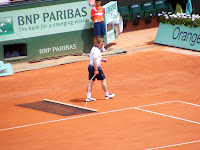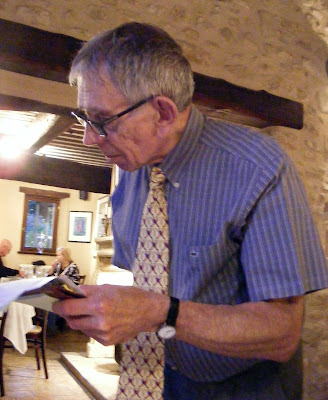My partner in crime this time, and last, was Catherine, an ex-colleague and nonetheless excellent friend who has now retired and moved back to her native Basque country. When she called me out of the blue from Paris instead of Biarritz and asked what I was doing Wednesday and if I’d like to go to the French Opens, for which she had two free tickets, the obvious answer was "Et comment!" (Hell yes!)
I met her at the Métro and we took two different subway lines to stop nearest to Roland-Garros Stadium. After that, it was easy to find our way because you could either just follow the crowds that looked pretty tennis-y or you could actually follow those little Roland-Garros tennis racket stickers that had been stuck all along the pavement, like Hansel and Gretel and their breadcrumbs. It was only one long city block away, under the trees to shield us from the hot French sun (everything’s relative) so we got there fast, but then the rat maze started. Since our last visit, terrorism has become part of everyday reality. Security was a new feature. All backpacks, etc. were looked through - rather superficially - and the tops of all water bottles were confiscated (???!!!) but not the bottles. Then you had to scan your ticket (which has an electronic circuit on the back!) and only then were you allowed inside the Stade Roland-Garros, named after a French aviator who was a World War I hero.
The layout of this tennis complex has also changed since my last visit. Gone are the days when tennis was a gentlemen-only sport. The whole complex was updated and expanded last year. Where there once was just a restaurant and a few booths selling gourmet ice cream, now there are permanent stands all along the walkways, selling drinks (including beer) sandwiches (gasp!) and all varieties of tennis-related tchotchkes. Nonetheless, the place is still full of trees and landscaping between the three huge stadiums and 18 courts. Almost 32 acres. 273 million euros in the making.
So by the time we actually reached our seats - on the Court Central, the most prestigious court - it was pretty much the end of the day’s first match: Victoria Azarenka of Belarus vs. Dinah Pfizenmaier of Germany. But we probably didn’t miss much, based on the few final games we did see. Final score: Azarenka mopped the court with Pfizenmaier 6-1, 6-1.
As I was underwhelmed by the game, I’ll let Roger speak for himself, as he did in one of his three interviews - in French, in English and in German, Switzerland being a multilingual country. "When you’re the clear favorite, the hardest part may be the press conference afterwards. Because you have to comment on a match where there’s not much to say. (...) And if you’re unfortunate enough to drop a set, like I did today, it’s a big deal. (...) Some of the decisions I made weren’t great ones. But I had a wide margin and I didn’t lose my service, so I’m okay with it." [my translation]All in all, it was a ho-hum match. Final score 6-3, 6-2, 6-7 (6/8), 6-3. And a record broken: t he number of Grand Slam wins, previously held by Jimmy Connors. Other factoids of the day: it was Federer’s 50th win at Roland-Garros and his 234th in a major tournament. Add to that the record of Grand Slam titles for which he has 16 trophies on his various shelves back home and you’ll see why the outcome was no surprise.
One fun part of the whole experience was that the delightful couple next to us was from Geneva and the couple in front of us from Neuchâtel, plus another guy two rows up with his red Swiss-flag hoodie with SUISSE on the front. How did they know my grandfather was from Switzerland? And why were we all grouped together?
Next came a French home boy, Gilles Simon - ranked 12th worldwide. His opponent: Brian Baker from Nashville, Tennessee, classed a mere 141st. Expectations were that the Froggy would make mincemeat of the Yank, as Simon had done with another American, Ryan Harrisson, in the first round. And that’s what it looked like after the first two sets, which Simon won 6-4 and then an easy 6-1.
And then something happened. Simon was ahead 5-3 in the third set, but somehow he came apart at the seams. Suddenly he found himself running back and forth, missing shots, hitting long or wide or long and wide. He rallied, but play went into a tie break which Baker won 7/5. Was it hubris that hit Simon? Did he underestimate his adversary, based on what he’d seen so far? Was it the problem the French players have long suffered from: la peur de conclure, the fear of winning?
Whatever the cause, it sapped Simon of his mojo. The Yank went on to molest the Froggy in the fourth set, 6-1. And it started to look like Baker might just make it into the third round. But then the Yank checked out. "Baker has left the building." Simon swept the fifth set 6-0. A killer service helped, the fastest of the day at 204 km/hr (127 mph). It was the expected outcome but not the expected itinerary. Final score: 6-4, 6-1, (4) 6/7, 1-6, 6-0.
And excuse me for saying this, but it was a much more interesting game than Federer’s. Especially given that Baker was sidelined for almost six years in 2007 by five surgeries: three on his hip, one on his elbow, and one sports hernia! He didn’t play on the tour again until last year but seems to be trying to make up for lost time. At age 27, he’s still young enough to create problems like this again.
Last on the dance card for the Court Central was Venus Williams. Her sister Serena had been drummed out of the roll call the day before by Virginie Razzano of France. Would Venus make it through where her younger sister hadn’t? With her 32nd birthday in June, I doubted it, but I was unfamiliar with her opponent: Agnieszka. Radwanska of Poland. Not a leading tennis country, Poland, but then again, America used to be the tops and look at it now. Venus looked plodding when she walked, zomby-esque when she stood but energetic when she moved. Unfortunately, she didn’t move fast or well enough. Radwanska was a discovery for me, which shows you how much I’ve been ignoring tennis lately, given that she’s ranked 3rd worldwide. She’s fast on her feet and plans out her shots but can take advantage of an opening when one comes her way.
The dark clouds over Roland-Garros that had been threatening ever since the fifth set of the Simon-Baker game had grown ever more ominous. After four unimpressive sets for the American, we decided to leave. After buying an official T-shirt for my grandson on the way out, Catherine and I reached the Métro without a raindrop falling and settled in for the hour-long ride home. We talked about all we’d seen, and much more. When I came out of the subway at Abbesses, the rains that had held off over Roland-Garros had just broken, so I walked home in the rain. Unfortunately for Venus, the rain gods hadn’t been kind to her. She might have done better if rain had stopped her game, but it didn’t and she lost miserably in straight sets: 6-2, 6-3.
P.S. Like Venus, Agnieszka also has a younger sister who plays tennis: Urszula.
































